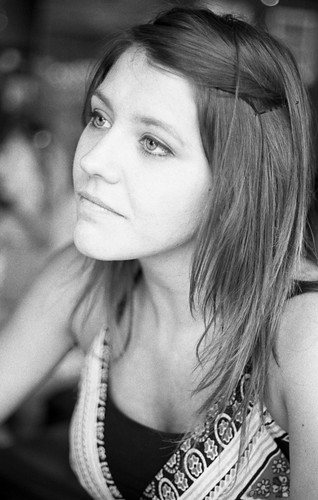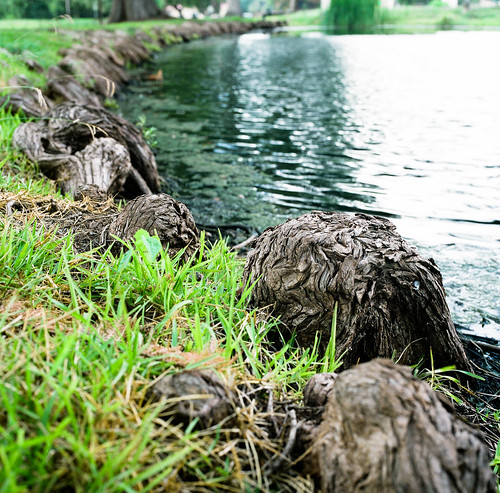Wednesday, September 12, 2012
Week 12 - Sarah
Sometimes it feels like everything is going right. The light is perfect, your framing is inspired, and you're getting great shot after great shot. And other times nothing works; everything you touch turns to crap.
And sometimes you shoot an entire roll of film and only get one good photo.
I think it's this situation--one gem out of a bunch of dirt clods--that is sometimes the most perplexing. It makes you wonder if that one great photo wasn't just pure luck. Clearly you weren't doing anything right the rest of the roll; why should you suddenly remember how not to suck? No, you think, must have been luck.
I don't think it's ever that absolute though. Matters of creativity are complicated. Maybe it was just a matter of the right factors coming in to play at the right time. Maybe all your other pictures were terrible because your rhythm wasn't right, or because you were working as if the conditions were different. Or maybe it is just luck sometimes, and maybe luck is what makes--forgive me--art. At least sometimes.
That's not the lesson I think I should take from this, though. I think the important thing for me to take away is that even on your bad days you're capable of doing something good. You just gotta keep going. Because you never know--maybe that next photo will be the one good one.
My sister came in to visit this weekend and I took an entire roll of film at lunch. This is the only one that was any good. But I like it so much that I'm perfectly fine with it.
Tuesday, September 4, 2012
Week 11 - Cube Bot

Of Robots and Equipment Failure
I had fun with the photos this week, but they're nothing special. There's a reason for that. I didn't take these pictures for art, I took them for science. Good thing I had a sweet wooden robot that my friend Dana gave me.You see, the magazine on my Hasselblad appears to have issues. That's the part into which you load the film; it also controls the spacing between frames. Sometimes (and only sometimes, because if it was predictable it would be easy and heavens we can't have that) it overlaps two frames or, alternately, places all the frames ridiculously far apart from each other.
Before I took yet another piece of my camera to be serviced, I wanted to put a roll through and see if the problem would manifest again. That's where cube-bot comes in.
 So this week I don't have any really interesting shots to share, just some black and white pictures of a robot toy made out of wood and elastic bands that was given to me by my friend Dana.
So this week I don't have any really interesting shots to share, just some black and white pictures of a robot toy made out of wood and elastic bands that was given to me by my friend Dana.It's pretty cool, though. Dana was the first friend I made in Austin and during the 13 years I've known her, she's never given the wrong answer to the question "how does Tate feel about toys that look like robots?"
(The answer is "he likes them very much thank you.")
What did Cube Bot teach me? Not much, sadly. No major issues with the frames, but they were still spaced apart from each other pretty crazily. So I took it in earlier today and probably won't be able to use my camera for weeks. Also, he taught me that I still hate the walls in my apartment.
 But I can't actually say I'm all that upset about not being able to use the camera for a while. The thing has been a lot of fun but also a lot of stress. It's going to take me years to get fully comfortable with it, and until then I'm going to continue to frustrate myself.
But I can't actually say I'm all that upset about not being able to use the camera for a while. The thing has been a lot of fun but also a lot of stress. It's going to take me years to get fully comfortable with it, and until then I'm going to continue to frustrate myself.It's going to be nice to get back to the gear with which I am already comfortable, and the freedom in 35mm to shoot more frames won't hurt either. It's almost like I've been given an excuse to stop thinking about the gear and get back to thinking about the images. I can dig it.
Anyway, Cube Bot thanks you for stopping by. He can't calculate much, being made of wood, but he generally does what he's told. Also, as wood is an organic material, he's technically more closely related to humans than he is to robots of the metal flavor; this is good news for us if (when) the robots revolt.
Tuesday, August 28, 2012
Week 10 - State
I don't shoot a lot of color.
I realized that, since getting my new Hasselblad with its expensive German lens, I haven't even bothered to see how color looks through it. So, when I drove Rachel down to San Marcos for a school function, I decided to shoot a roll of color on campus and see how it turned out.
I learned a few things.
First of all, the film magazine on this thing is unreliable and sometimes does strange things. Once, I had it overlap three photos so that the bottom of one frame cut through the middle of a woman's head. This time, however, it just offset its frames by one so that instead of 12 shots, I got 11 shots. It just started at #2 and only pretended to shoot the final frame.
This, the Internet tells me, can be easily fixed. Well, relatively easily. It's a common failure and can be fixed by cleaning and re-lubricating the magazine. This can be done by a qualified technician, of which Austin apparently has a few. But, as with all European mechanical objects, it's not exactly cheap. Or fast. So I'm going to have to give the camera up--again--for probably a month or two and drop another bill on it.
Second, I learned that I really need to get a hood for this thing. The lens I own is so old that it predates modern lens multicoating, meaning it flares pretty badly. Again, nothing made for this camera is cheap.
I feel like I understand what "car guys" go through when they try to buy and maintain classic cars. You love the thing, but damned if it isn't a giant money pit.
Oh well. Pictures:
I've done better, but at least the quality of the photos is nice. I can see why, in optimal condition, these cameras are so well regarded. I just wish I'd bought one in optimal condition.
Sigh.
I realized that, since getting my new Hasselblad with its expensive German lens, I haven't even bothered to see how color looks through it. So, when I drove Rachel down to San Marcos for a school function, I decided to shoot a roll of color on campus and see how it turned out.
I learned a few things.
First of all, the film magazine on this thing is unreliable and sometimes does strange things. Once, I had it overlap three photos so that the bottom of one frame cut through the middle of a woman's head. This time, however, it just offset its frames by one so that instead of 12 shots, I got 11 shots. It just started at #2 and only pretended to shoot the final frame.
This, the Internet tells me, can be easily fixed. Well, relatively easily. It's a common failure and can be fixed by cleaning and re-lubricating the magazine. This can be done by a qualified technician, of which Austin apparently has a few. But, as with all European mechanical objects, it's not exactly cheap. Or fast. So I'm going to have to give the camera up--again--for probably a month or two and drop another bill on it.
Second, I learned that I really need to get a hood for this thing. The lens I own is so old that it predates modern lens multicoating, meaning it flares pretty badly. Again, nothing made for this camera is cheap.
I feel like I understand what "car guys" go through when they try to buy and maintain classic cars. You love the thing, but damned if it isn't a giant money pit.
Oh well. Pictures:
I've done better, but at least the quality of the photos is nice. I can see why, in optimal condition, these cameras are so well regarded. I just wish I'd bought one in optimal condition.
Sigh.
Monday, August 20, 2012
Week 9 - Out and About with the 'Blad
Even once you technically understand how to use a new camera, there's still a good long period of acclimation before you really get a feel for it. I would say that, right now, I'm most comfortable with my 35mm Nikon F3; I've gotten to the point that I know where the controls are almost through muscle memory. I don't have to think about the equipment, it fades into the background and I just shoot.
I am not there yet with my new Hasselblad. It's bigger, heavier, uses a strange square aspect ratio, and is not exactly built for quick snapshots. It has promise, and I want to get comfortable with it, but I'm not there yet.
I don't have a lot of insightful commentary this week. Mostly I have been trying to take the Hasselblad out more and get used to shooting with it in public. This isn't the easiest thing to do because it's about as subtle as dump truck, but I think that we've reached a point as a society that no mechanical film camera with knobs on it is going to escape notice. I just have to embrace the fact that I'm walking around with an anachronism around my neck.
Here are some images I shot this week while I was out eating and walking around.
I'm still getting used to the square format. It is really interesting for some shots but really frustrating for others. Working in 35 (and making movies) teaches you to visualize everything in rectangles, and it's a hard habit to break.
That's all for this week. Thanks for dropping in.
I am not there yet with my new Hasselblad. It's bigger, heavier, uses a strange square aspect ratio, and is not exactly built for quick snapshots. It has promise, and I want to get comfortable with it, but I'm not there yet.
I don't have a lot of insightful commentary this week. Mostly I have been trying to take the Hasselblad out more and get used to shooting with it in public. This isn't the easiest thing to do because it's about as subtle as dump truck, but I think that we've reached a point as a society that no mechanical film camera with knobs on it is going to escape notice. I just have to embrace the fact that I'm walking around with an anachronism around my neck.
Here are some images I shot this week while I was out eating and walking around.
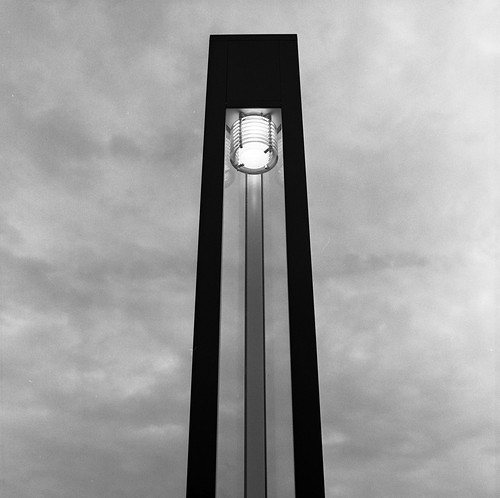 |
| Light fixture at the Crestview light rail station (next to Black Star Co-op) |
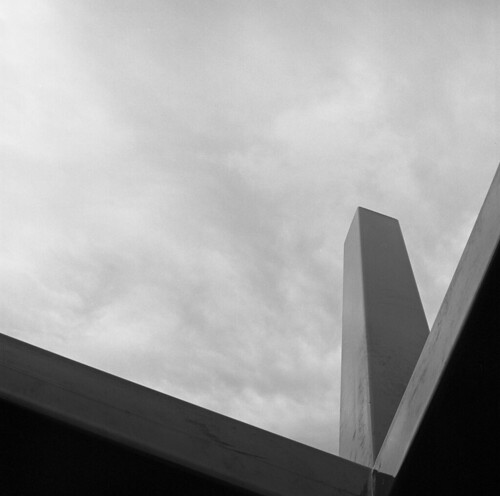 |
| Sculpture next to the Crestview light rail station |
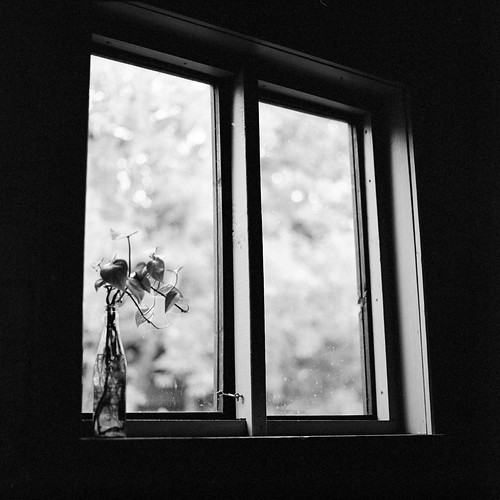 |
| Epoch Coffee, North Loop |
 |
| Landscaping along Victory Drive |
 |
| Fire hydrant along Victory Drive |
I'm still getting used to the square format. It is really interesting for some shots but really frustrating for others. Working in 35 (and making movies) teaches you to visualize everything in rectangles, and it's a hard habit to break.
That's all for this week. Thanks for dropping in.
Tuesday, August 14, 2012
Week 8 - sushi
Quit Thinking So Hard
Rachel suggested to me recently that in my zeal to practice deliberate, planned, painterly portraits, I was running the risk of neglecting what she considered to be one of my strengths: spontaneous portraiture. I usually keep a 35mm camera in my car and tend to take it out whenever we're at a restaurant or a coffee shop (I finished graduate school but Rachel didn't, that's about all you have time to do in her shoes).The result is that I have about a billion pictures of Rachel drinking tea, but I also end up with some good pictures not only of her but of my other friends as well.
 |
| Like this one from 2011, at the old Kerbey Lane location on South Lamar |
 |
| Or this one of my friend Don, also from 2011, at the Parlor in Hyde Park |
So, with that in mind, I took my Nikon F3HP with me when we went out for veggie sushi at one of our favorite places, Banzai. That's when the fun started.
They're Talking About Us
As usual, I sat down with Rachel at a two-top and started snapping away. One of the great things about buying film in bulk is that you can usually afford to be liberal with your shots; coupled with my sometimes-troubling lack of compositional discipline, this leads me to take all kinds of crazy pictures.Thus, the sight of me leaning in and out of Rachel's face with a camera and shooting weird things like her hands is a fairly common one if you hang out in the same restaurants we do. I am actually quite mortified of being disruptive or making people uncomfortable--which is why I'm afraid of street photography--so while I'm sure I look silly I try never to bother anyone. I won't even fire the shutter if it's very quiet in the room.
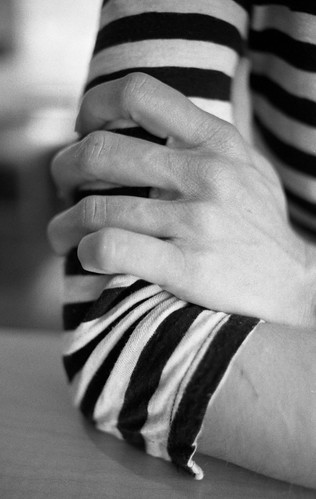
At one point while we were there, I decided that I was tired of the angles available to me from where I was sitting. Rachel (because she is an amazing sport and very supportive) suggested that we switch sides, which would move the light to another side of her face and change the background.
That's when she noticed it.
Two college-aged girls sitting at a table in another part of the restaurant apparently thought it was worthy of their scorn that I should take pictures of my partner in a restaurant. Rachel noticed that they were giggling and overheard one of them say "oh, now they're changing sides." She said this in a tone of voice one would use for the punchline to a hilarious joke.
One of them was wearing a UCLA shirt, leading me to believe she's at least spent some time in Los Angeles. I find it hard to believe she never encountered people taking photos in public before. Perhaps I'm biased, but when I encounter people taking photos in public my thoughts are generally either "crap, am I in their shot?" or "is that a Leica?"
My point is: these girls were judging us for doing something perfectly acceptable and that I would think could be seen as sweet. I still like taking Rachel's picture after five years, and while I usually don't like drawing attention to myself in public I am damn sure not ashamed of making nice pictures of the woman I love.
 Rachel immediately locked her s-foils in attack position and, not quietly,
said "those girls are laughing at us. I hope they can read my lips
right now."
Rachel immediately locked her s-foils in attack position and, not quietly,
said "those girls are laughing at us. I hope they can read my lips
right now."Apparently they could because they immediately got very uncomfortable and refused to make eye contact with her. Perhaps they could feel the shame-stare. Says Rachel: "I usually try really hard not to be formidable, but I made an indignant exception."
I for one thought the entire experience was highly amusing.
"They can. They know I caught them. They're not even looking over here anymore." And, sure enough, within a few minutes they quietly and quickly walked out the restaurant past us while averting their eyes.
While some college kids laughing at me is really the least of my troubles, I still wanted to tell this story. I'm trying to decide if there's anything I can learn from it, and the best I can come up with after thinking about it is this:
When you practice a creative hobby, sometimes you'll look silly. Maybe you won't look silly to everyone, and maybe you won't look silly all the time. But sometimes, somewhere, someone is going to give you a hard time for it. And that sucks.
I said earlier that I'm afraid of street photography because I am afraid of making a scene or getting in people's faces or interrupting their privacy. I don't particularly like being the center of attention, despite what you may believe if you saw the stuff I did on college TV. But the thing is this: carrying around a 30+ year old manual film camera in public is going to make me an object of interest. I'm going to have to deal with the fact that people are going to notice it, they're going to say things, and yes, they may laugh at me.
But at the end of the day, I'm the one with the nice photos. So whatever.
Sunday, August 5, 2012
Week 7 - Production Stills
Speed...Mark...Action
This post will be a bit of a departure from my previous posts about portraiture. I recently worked on my friend Don's short film (he and I have a little film outfit going). In addition to the other odd jobs I did on set, I took my Nikon F3 along and shot many rolls of production stills.Most people these days shoot production stills in digital and in color, but of course I'm me so I did it in film and black and white. But it worked out, because the movie has a vaguely-defined 50s or 60s vibe to it and is itself going to be in black and white, so Don was actually excited that I'd be doing the stills traditionally.
There isn't much to say about these, other than I found it a nice change of pace to do on-the-fly "documentary" style photography. I tried to catch any interesting moment I could, and being a producer on the film meant that people didn't generally question my shoving a camera in their faces.
Don asked me to avoid spoiling too much of the film with the photos I post. I had to leave out some of the shots I'm really proud of, but not all of them.
Without further delay, production stills from the newest Jollyville Pictures short, tentatively titled "The Horrible Life of Dr. Ghoul," directed by Don Swaynos and starring Chris Doubek, Jason Newman, Kerri Lendo, Byron Brown, and Jessie Tilton.
Click the images for larger versions.
 |
| Nathan Smith and Jack Lewandowski |
 |
| Nathan Smith |
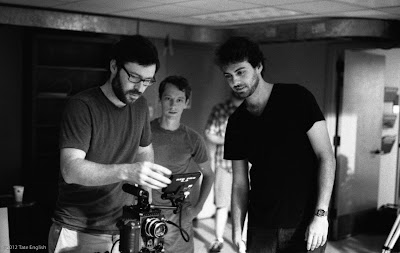 |
| Ted Griffis, Jack Lewandowski, Nathan Smith |
 |
| Kerri Lendo, being made-up by Lauren Gonzalez |
 |
| Chris Doubek |
 |
| Kerri Lendo and Chris Doubek perform a scene |
 |
| Kerri Lendo and Don Swaynos |
 |
| Byron Brown, Jessie Tilton, and Chris Doubek |
Tuesday, July 31, 2012
Week 6 - no pics
Just a quick update - I did in fact shoot several rolls of film this week, but they were all production stills for a movie I was producing. I will post shots as soon as I've gotten approval from the director to publicize things, hopefully by next week.
Monday, July 23, 2012
Week 5 - Hasselblad
The Blad is Back
When I finished graduate school and got my Master's degree, I decided to buy myself a graduation present. I have, for as long as I've been interested in photography, wanted a Hasselblad V series camera. You may remember it as the camera on the cover of that Elvis Costello album.So I went ahead and bought one from a gentleman on craigslist. And a week later its shutter broke.
To be fair, I don't think he knew he was selling me a not-quite-broken camera, he just hadn't had it serviced in a while and probably didn't use it much. Caveat emptor and all that. But it was still a big blow; I was given a taste of the dream and then had it yanked away from me.
So I sent it off to Massachusetts, to the best Hasselblad technician the Internet could recommend. One month and several hundred dollars later, it came back in like-new rebuilt condition. I was ready to lock and load.
I shot two rolls on Sunday the 22nd. Here are the highlights.
Roll 1 - Rachel in the Window
 | ||
| Portrait of Maud Cook Thomas Eakins, 1895 - image from Wikipedia |
- Don't get too fancy with your composition. If you throw in a lot of context, you'll probably end up cropping it out later. Focus on faces.
- Cool it on including the light source in the photo.
I took as my inspiration another Eakins painting, Portrait of Maud Cook. It is another fantastic portrait that uses a directed light source to display the subject in a pleasing, if not necessarily flattering, light. Eakins was known for the strong realism in his portraiture, he didn't try to make people look younger or prettier than they were. But for all that, their direct presentation still leaves people looking attractive. I think that's what draws me to them.
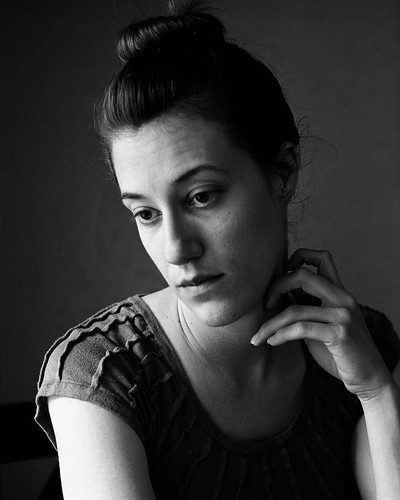 I sat Rachel by a window and set about shamelessly
I sat Rachel by a window and set about shamelessly Thus, these shots are cropped to an 8x10 aspect ratio. I am less upset this week about that, though, because I shot these intending to crop them. All that's missing is about another two inches of that grey wall to Rachel's right.
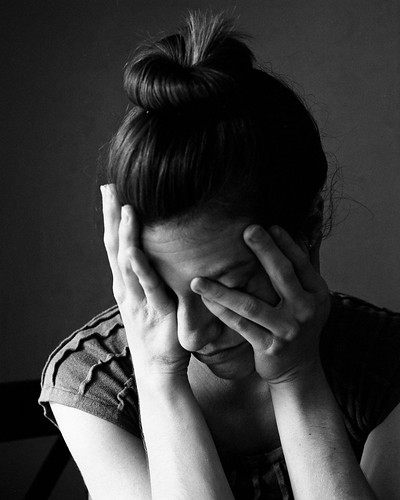
I'm very happy with the way my new lens handled the contrast on this; coupled with the relatively grainy Tri-X film I shot them on, I think they almost have an abstract quality that is similar to the painting that inspired them.
I really like the photo of Rachel holding her head in her hands, and I'd like to claim that I directed her to do that, but that's a genuine moment. She was feeling a little tired and a little frustrated with me for making her sit by the window for so long while I fiddled with my new camera.
Thus, another lesson. I need to work on not only my technical skills, but my interpersonal skills as well. Rachel lets me take her picture all the time, she's used to me--but some people are going to be nervous about having their picture taken.
My "bedside manner" if you can call it that could stand to be improved. I am usually too focused on the technical aspect of the image and not on whether or not my subject is at ease. I think it comes partially from my personality, which is not terrifically gregarious, but also from my background in filmmaking. Perhaps if I were a documentary filmmaker I'd have learned something about putting my subjects at ease, but as a narrative filmmaker the people with a camera pointed at them all want to be there and more often than not have done it before.
Roll 2 - Campus
After shooting with Rachel, I went to the University of Texas campus to play with my new lens outside. Not shooting people allowed me to both use the native square format of the film and also focus more on textures. |
| Main Building |
 |
| Calhoun Hall breezeway, South Mall |
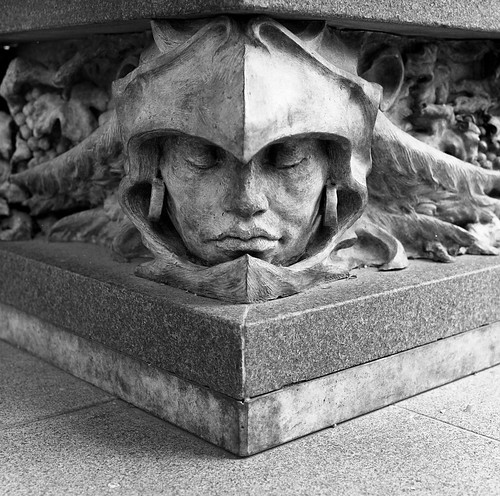 | |
| Cesar Chavez statue, West Mall |
I look forward to getting more comfortable with my new camera. Thanks for reading, I'll keep trying to post something new every week.
Monday, July 16, 2012
Week 4 - Emulating Eakins, Foiled by a Lamp
Lessons from Portraiture
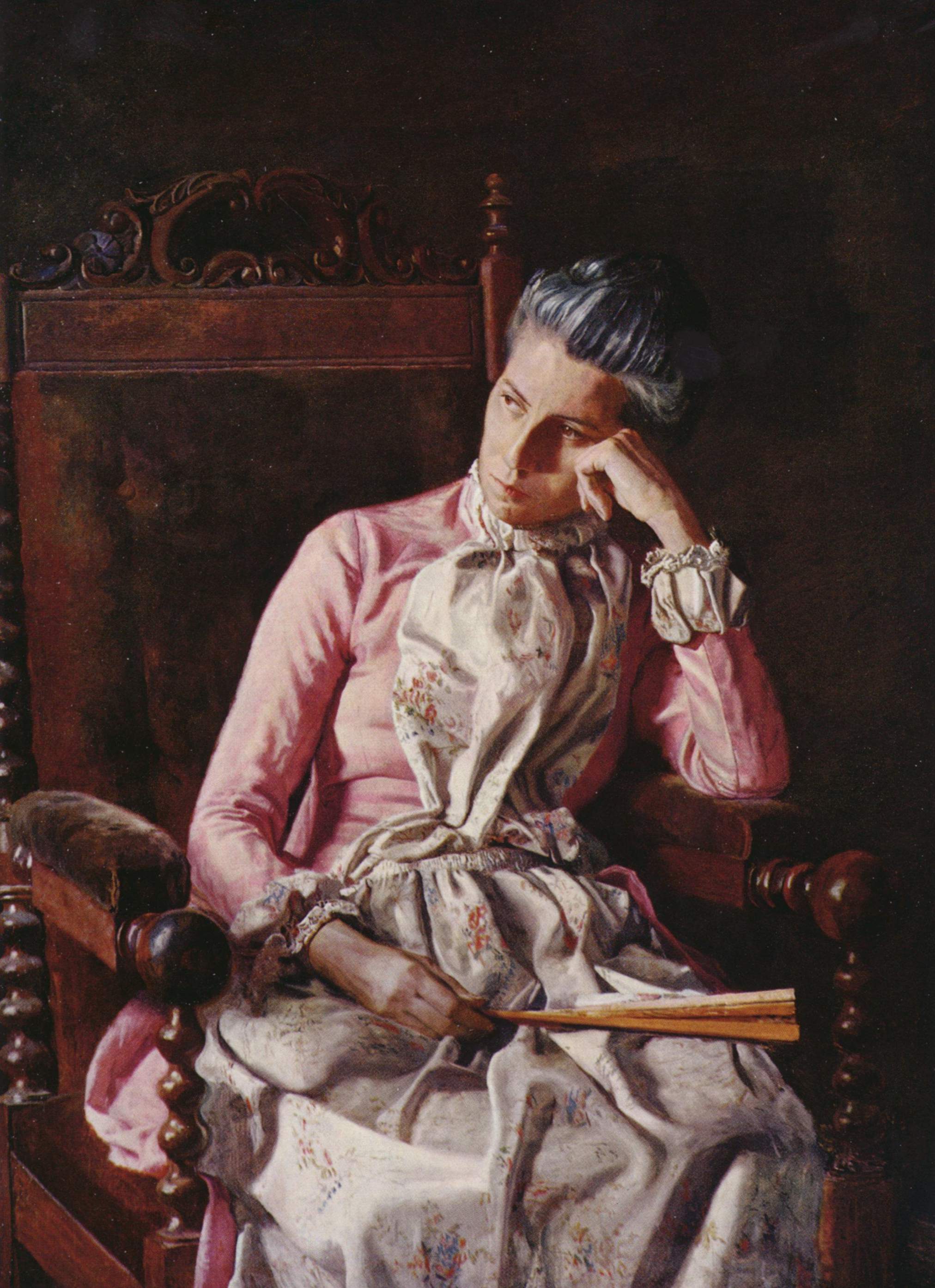 | |
| Miss Amelia Van Buren Thomas Eakins, 1891 - image from Wikipedia |
I came upon Eakins when I was looking for inspiration for portraiture. When you are a writer, especially before you have discovered your own style, you are supposed to find a writer you like and shamelessly copy him/her until your own voice emerges. I thought that I would do well to think along the same lines.
I find myself interested in very expressive, moody use of light. In film school, I had a cinematography teacher tell me that studying paintings was a great way to get a feel for artistic use of light; now, here I am, ten years later, listening to her.
Anyway, I decided that I would sit down with Rachel and try to get a very deliberate portrait, inspired by Eakins (and especially the painting of Miss Van Buren). I'm sure it would take a lifetime of study to fully appreciate everything a master painter does, but I observed a few things from his style that I could immediately emulate.
First, subjects almost never look toward the viewer. This gives the portrait more of a "narrative" feel--what are they looking at? What are they thinking about? If they look at you, they are engaging directly with you, but if they're focused on something else, they're enigmatic.
Second, light is strongly motivated from one side, and shadows are important.
I generally try to do these things already, but not in as deliberate or careful of a way. So I got my medium-format camera, moved a bunch of stuff in the living room around, and put Rachel on the couch.
That Damn Lamp
 |
| HAI I'M A LAMP LOL |
While shooting, I thought I had everything lined up beautifully. However, after developing and seeing the photos on the proof sheet, I immediately realized two errors.
The first is relatively minor. There's an ugly seam on our wall behind the couch that I thought would be in shadow. I should have read the light back there; if I'd known you could see it I'd have reframed the shot.
The second problem, though, is kind of a big deal to me. It has to do with that lamp.
I thought the lamp would look cool; it would be obvious where the light was coming from and it would contrast with the relatively darker area of the subject. Having seen the photo, though, I completely disagree. It takes up almost a quarter of the frame!
Here I have this somewhat interesting scene, and there's a giant glowing eye magnet taking up the top right of the frame, saying "hey look at me, even when you're looking at the woman on the couch you're trying to keep looking back up at me. I'm the brightest thing in the shot!"
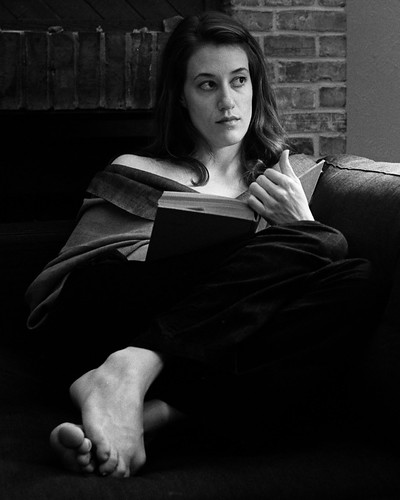 |
| That's better. |
This crop is basically what I was trying to do from the start, and I'm kicking myself a little that I didn't just do it in-camera. This is the process that Ansel Adams calls "visualization:" you don't just shoot and hope that something turns out, fixing it later by cropping. You imagine exactly what you want the final picture to look like, and then you manipulate the camera and film to get that image. That's what I'm striving for.
That being said, I got what I think is a very nice photo out of it, so it's not all bad. I'm just going to chalk this one up to experience and try again next week.
Bonus!
The day after I took the photo above, I took this one on 35mm. I don't have an instructive story to tell about this photo, but I like it. So I'm sharing it.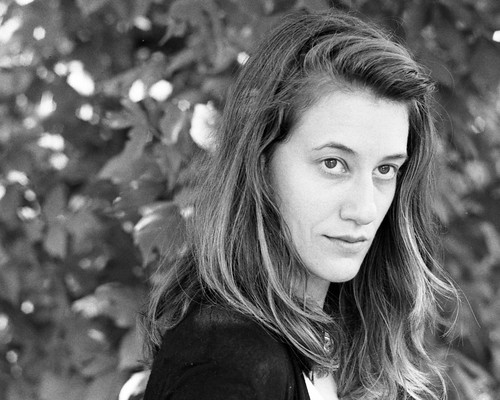
Thanks for stopping by. Drop me a comment if you like. I should have a new post next week, hopefully.
Monday, July 9, 2012
Week 3 - Flash
Meh.
The point of this blog is to shoot something every week and talk about it, in an effort to focus on and get better at my photography. Unfortunately, that means that not every week is going to be amazing. I almost didn't want to write something this week because I don't think the photos I did are very good, but I'm gonna power through.I decided that it was time to get over my hatred of flash photography. I actually already owned a flash that would work with my camera if I got an eight-dollar coupler, so I ordered the part and decided to spend the week experimenting.
First of all, let's look at this thing. I tell people that the flash for my camera is comically gigantic and I don't think anyone fully believes me. Here it is, next to a gin bottle for scale (and also because I was drinking gin). It's probably 150% as tall as the camera. It is a hilarious monstrosity and I almost am ashamed to take it in public. And to cap it all off, it has not one but two flash heads on it.
To be fair, that second flash head is pretty cool. It's fairly weak and is just there to soften shadows on peoples' faces. But the whole package just screams LOOK AT ME I'M A FLASH in a glorious, angular, 1980s way. This camera and flash set are from the era of the boombox; small wasn't really "in."
So I mounted that thing up and took some pictures of Rachel. Here's the first shot I took:
As you can see, the exposure is fine but it's kind of boring. I angled the flash head and bounced the light off the ceiling to keep it from being too harsh. Unfortunately, this is about as good as it was going to get.
We went out to eat and sat on the patio. There was obviously no ceiling from which to bounce anything, so the shots I took there were with the flash head dead-on. Sometimes it's almost passable:
 |
| A little harsh, but it'll do. |
And other times it's not.
 |
| People do not actually glow. |
We came back home and I bored her to death by making her sit for something like 20 shots in which I angled the flash head differently every time and took careful notes.
So what did I learn? I still hate flash photography. But I could stand to practice it more and hate it less. I can see that it could be useful in a studio setup, where the flash isn't on the camera itself but on a second tripod and at a different angle. That requires either a network of sync cables or very expensive modern wireless flash heads, neither of which I'm in the mood to acquire right now.
I may play with making a bounce card or a diffuser for the flash head, but I'm beginning to wonder if this is even worth my time. I'm not an event or wedding photographer, and I don't know if flash is something I need to learn. Part of me thinks that it's a waste of my time, but I suppose that if I become passable at using a flash and then intentionally never use it, I won't be worse for it.
Who knows, maybe it'll come in handy. I'm going to try to line up some natural-light portraiture this week, though.
Monday, July 2, 2012
Week 2 - Davida
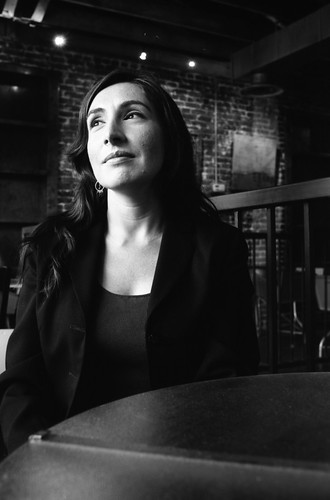 Take Pictures of People
Take Pictures of People
After my last blog post, Steve Metze (former instructor of mine, documentary filmmaker, and independent game publisher) suggested that I take pictures of people. I actually consider taking pictures of people to be my biggest strength in photography, but that's not to say I think I'm amazing at it. I just think that all of my best pictures are of people. This is one of the reasons I like to go and take boring pictures of trash cans sometimes--I'm trying to branch out.But there's plenty of learning for me to do in the world of portraiture. That's what this week is about.
The model this week is Davida Dwyer, a friend of mine from college. She is an attorney working in a state office, and I asked her if she needed any professional-looking lawyery photos. She's not in private practice, so she didn't really, but she humored me and we pretended she did.
I did two sets of photos with two cameras.
I used a medium format camera (my Yashica Mat 124) to take some color photos. I tend to focus almost entirely on black and white, so I felt that I should try to get some color experience. The difference in visualization and composition can be pretty strong between color and black and white, so I wasn't really sure how this would go.
Second, I took my trusty Nikon F3HP 35mm camera and shot some black and white. I did this mostly because I am more comfortable working black and white and I wanted to cover my bases.
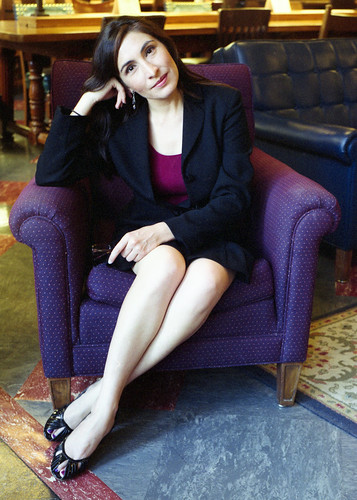 |
| Cropping after the fact leads to things like the edge of a couch poking in at the corner. |
Color
We shot the color photos inside the architecture library reading room in Battle Hall on the UT campus.I do not like flash photography, primarily because I am very bad at flash photography. I think I'm going to try to tackle that in a future edition of the blog. But for now, I needed to work with natural light, so I sat Davida by a window. This not only gave me ample light for photos but also ensured that the colors would come out correctly (if you shoot most color film under fluorescent light, everything looks nasty and green).
Unlike the rectangular 35mm format, the Yashica (along with several other medium format cameras) shoots in a 6 cm x 6 cm square format. I'm not so great at using the entire frame effectively. I ended up doing a lot of cropping after the fact. In a sense, this is good--I was able to get decent 8x10 crops out of these. But it was bad as well--I threw away a lot of the information on each negative to get to something I liked.
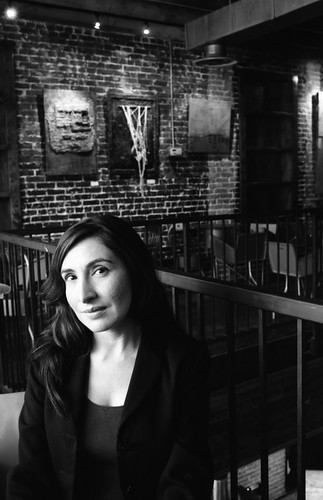 Black and White
Black and White
After we finished the color roll, we went across the street to Caffe Medici (which used to be called Metro, if you're of the same UT vintage as me). The upstairs loft there has one of my favorite big windows in town.I really love window light for black and white, but not because I need to worry about what color the light is. I love it because I am drawn to very directional, dramatic light. It creates nice contrast between the light and the dark in a frame and gives you great shadows.
I really do feel much more comfortable with black and white, and I think these photos are stronger than the color ones. I don't think they satisfy the goal of "professional portrait" but they suggest more of a story than the color ones. I guess it's hard to shake off all that film school.
Wrap Up
I'm much more happy with the black and white photos than I am with the color. While I feel like the color photos are technically good, they don't really appeal to me in the same way that the monochromes do. Part of that is my preference for black and white and part of it is my inexperience shooting color. Color portraiture often seems to be about using the color as a key element, almost as another personality in the shot. I know of people who do it beautifully, but I think that I have a lot of work to do if I want to work with it more often.All in all, not a bad week. Thanks to Davida Dwyer for letting me take the pictures, and thanks to Dano Johnson for reading the Onion out loud to us while we took the pictures. Dano, you're coming on all my photo shoots now.
Monday, June 25, 2012
Week 1 - Pease Park

Shoot, Damn It
I really wasn't sure what to shoot this week, but I decided I'd go out and shoot something anyway. One of the primary goals in starting this blog was to keep myself accountable; to kick my ass into going out and shooting something every week. I've heard the advice that writers get, that you should write every day regardless of whether or not you want to. Like exercise, it's supposed to make you better through sheer experience and repetition. I am trying to do the same thing (though not every day, it takes me long enough to develop and scan film as it is).So, on Thursday June 21st, I grabbed my Yashica Mat 124 twin lens reflex and a roll of film before heading out to work. I told myself that I would go and shoot SOMETHING after work. And while I don't think that what I shot was remarkable artistically, I am proud of the fact that I went out and did it. I tried to practice my visualization, not just to take pictures of anything and everything but to try and find the interesting shots available to me.
I'm pretty sure I did a crappy job at that, but you have to start somewhere. I think that every roll of film I put through a camera while being thoughtful about it, even if nothing is clicking that day, is good exercise.
Even though I don't think the pictures are that interesting, though, there are two interesting things I want to talk about with this roll.
Sunny 16
My Yashica Mat has a light meter built in to it, but it's busted and unreliable. I don't even look at it. This has, in the past, kept me from going out with this camera, which is a shame. It's fun to use and it's no heavier than any of my film SLRs.I recently decided that I needed to develop (get it, it's a photography blog) the ability to guesstimate my exposures without relying on a light meter. So I started practicing using the Sunny 16 Rule.
The fact that every frame of film I shot this week has an image on it means that I did pretty well. Most of them seem exposed correctly, too, so I seem to have been more or less on the money. Black and white film is pretty flexible, though, so I would still use a light meter if I was doing anything in color, or anything very important.
Still though, being able to go outside with a mechanical camera and say "I'm thinking I need to shoot this at f/4 and 1/125th" is freeing. It gives you a little more confidence not to have to rely on another device.
Plus-X
The other thing I want to talk about is the fact that I shot this on my second-to-last roll of Kodak Plus-X, which has been discontinued. This particular batch expired in January 2009. The one roll I have left will almost certainly be the last roll I ever get to shoot.Plus-X is the slower version of Tri-X, meaning it has finer grain but requires a lot more light. Tri-X has been my film of choice for forever. It's very forgiving--you can shoot it in almost any situation and you can quite frankly abuse it and you still get pictures. It's kind of an easy film to learn on in that regard. It's grainy and old-fashioned looking, but I don't mind. It's kind of like the black coffee of film.
Plus-X, on the other hand, never interested me. If I wanted something with less grain, I'd get one of the fancier slow-speed films. The benefit of Tri-X is its versatility, which Plus-X didn't offer to the same degree. I'm sure many people loved the film, and it's been around forever, so I'm not knocking it, but its discontinuance didn't bother me too much.
But all the same, it was kind of an icon. Sure, it was overshadowed by its faster, more versatile brother, but you always knew it was there. And now it's not.
 |
| You'd think I'd have corrected that framing. |
I don't think black and white film is going away. Kodak aren't the only players in the game: Ilford in England only makes black and white film and is a smaller, nimbler company that can tolerate smaller profit margins. Fujifilm is so diversified, and makes so much money, that they seem to put out old-fashioned products just to satisfy their own whims. And like I said, I never really shot this film.
But all the same, it's a sobering sign of the times. I have one more roll, and I hope I do it justice. Happy trails, Plus-X.
Tuesday, June 19, 2012
Last of the Steam-Powered Trains
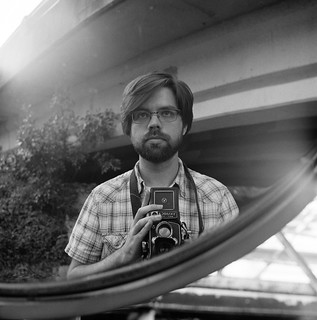 I've threatened to start this blog for a while.
I've threatened to start this blog for a while.I just finished graduate school, and I find myself with a great deal of spare time that had been taken up with reading about rhetorical theory. I knew that I should devote this newly-freed-up time to something I've been woefully bad at the last several years: focusing on photography.
I really enjoy photography. Specifically traditional black and white film photography. Oh, I'm not a professional, let me point that out right now. Sometimes I get lucky, I've taken some decent shots, but a quick Google Image search will show you that I'm not any sort of authority. All the same, I'm in love with the process. I develop my film at home in my sink. I rent darkroom space from a lab in town and print when I can. I find the experience to be meditative and deeply satisfying, even if I rarely find the prints to be so satisfying.
I decided months ago that I would spend a year focusing on photography, shooting every week, and posting the results on a blog to hold myself accountable. If I can look back on it at the end of a year and see improvement--even small improvement--it will have been worthwhile.
Two factors have finally pushed me to get on the stick: my birthday and a Kinks song.
I turned 31 this weekend. While that was not anywhere near as monumental a landmark as turning 30 (an event marked by a temper tantrum on my part followed by a great deal of gin), it did serve to remind me that procrastination is the enemy. I am not getting younger, and what better time to mark the start of an educational year than my birthday.
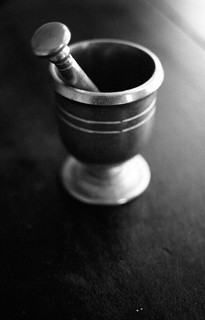 But more importantly, today I was listening to The Kinks Are the Village Green Preservation Society, and it put an idea into my head that pushed me to go ahead and do this. For those of you who don't know, that album is essentially Ray Davies' long-form exploration of nostalgia. He sings about the England of his youth besieged by "American tourists;" about his old friends forgetting his name; about the good old days that won't return. But at the same time, what makes the album work is that Davies is obviously aware that it's all a fantasy. Nostalgia is a longing for what you remember, not what was; what you remember was never actually there to begin with. It's just a story you tell yourself.
But more importantly, today I was listening to The Kinks Are the Village Green Preservation Society, and it put an idea into my head that pushed me to go ahead and do this. For those of you who don't know, that album is essentially Ray Davies' long-form exploration of nostalgia. He sings about the England of his youth besieged by "American tourists;" about his old friends forgetting his name; about the good old days that won't return. But at the same time, what makes the album work is that Davies is obviously aware that it's all a fantasy. Nostalgia is a longing for what you remember, not what was; what you remember was never actually there to begin with. It's just a story you tell yourself.In particular, I am thinking about the song "Last of the Steam-Powered Trains:"
Like the last of the good ol' choo-choo trains,
Huff and puff 'till I blow this world away,
And I'm gonna keep on rollin' till my dying day.
I'm the last of the good old fashioned steam-powered trains.
For me this song captures the inspiring, confrontational, here's-mud-in-your-eye feeling of thinking that you are the last of a dying breed. You're a flag-waver for an older, more pure way of being, and damn the torpedoes, you're going to keep on rollin' till your dying day. You against the world! It's a satisfying fantasy, but it's just a fantasy.
I indulge in this fantasy sometimes.
I'm not against digital cameras at all, but I'm also not interested very much in them. Photography for me is about the experience, and I admit to feeling a certain bit of pride in using 30-, 40-, 50-year old equipment to make an image. Autofocus makes me uncomfortable, I want to set the aperture by clicking the barrel, and I eat film grain for breakfast. I admit that, in my less-than-good moods, I get kind of a chip on my shoulder about it. And then I get to thinking that I'm the last of a dying breed, and that film photography is some sort of grandiose fight-the-power lost cause.
But that's a stupid way to live. Love for the past and respect for a way of working is one thing; making it into an oppositional fantasy is something else entirely. I catch myself thinking along these lines--that by working in an old-fashioned medium, I'm somehow making a statement to the whole modern system--and it's silly. It's like Andy Samberg throwing everything on the ground.
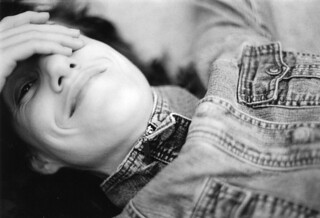 Ansel Adams says that photography is "an inclusive language." There's no shortage of pictures to be taken or ways to take them. I am not the last of the steam-powered trains, and this is not a race. I am just a guy who loves his cameras and wants to do the best he can.
Ansel Adams says that photography is "an inclusive language." There's no shortage of pictures to be taken or ways to take them. I am not the last of the steam-powered trains, and this is not a race. I am just a guy who loves his cameras and wants to do the best he can.Let's see where the year takes me.
Subscribe to:
Posts (Atom)
